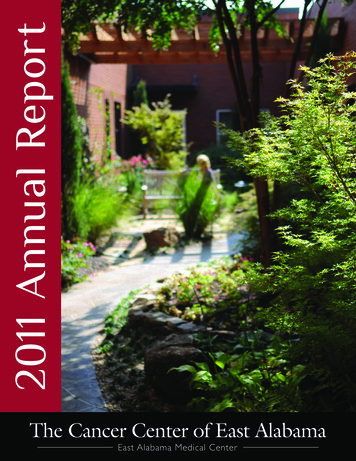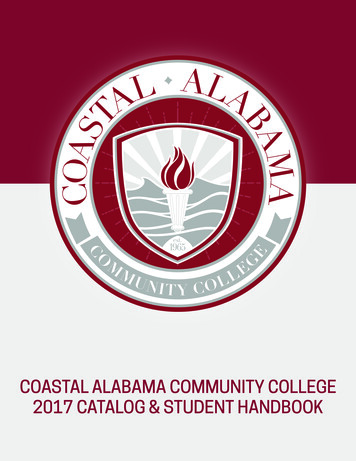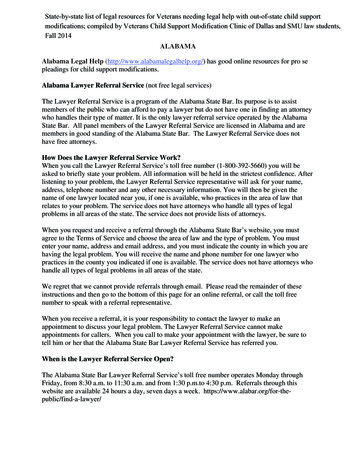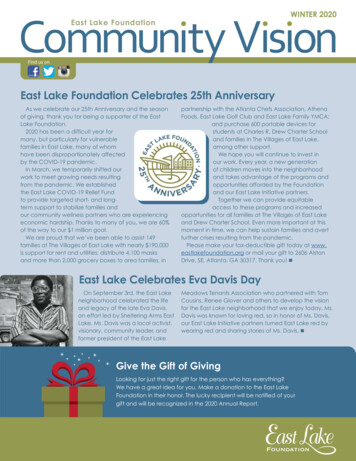
Transcription
2011 Annual Report
From the PresidentThe Cancer Center of East Alabama continues to serveas a resource in the community for cutting-edge cancercare, as well as cancer education, awareness and support.Technology is continually evolving. In 2010, EAMCadded the da Vinci Robotic Surgery System, 3T MRI at theAuburn MRI Center, and stereotactic radiosurgery. Thesenew tools allow physicians to diagnose diseases earlier,perform surgeries with minimal blood loss and quickerrecovery times, and provide the latest treatment for braintumors and certain head and neck cancers.Another new service that enhances our patients’ treatment is the Robert and Marjorie Goodson Oncology Wellness Program. This program was created with fundingthrough a generous contribution from the estate of Robertand Marjorie Goodson, and is a collaboration between theCancer Center of East Alabama, HealthPlus Fitness Center, and RehabWorks outpatient rehabilitation. Anothergift from the Goodson estate is Goodson’s Garden, a special space located in the area between theCancer Center and The Surgery Center. This area includes a four-season garden, sculpture, music anda water feature, and was created for cancer patients and their families as a relaxing space for conversation, prayer or meditation.In its focus on fighting cancer, providing support andincreasing awareness, cancer center staff and physiciansEAMC’s Mission,served approximately 2,500 people in our communityVision and Valuesthrough screenings, support groups, and other activities.For example, more than 300 women and men benefitedMISSIONfrom free mammograms, colorectal cancer screenings orHigh quality,prostate-specific antigen (PSA) tests for prostate cancercompassionatein fiscal year 2010. Activities like the Think Pink breasthealth carecancer awareness walk and the annual cancer survivorsVISIONpicnic touched hundreds of lives as well.To be a nationalI am pleased to see the progress made in the fight againstleader in quality,cancer by the staff and physicians in the Cancer Center.Their compassion and expertise – along with the latestcost and servicetechnology – place them at the forefront of cancer care.Terry AndrusPresident and workThe Cancer Center of East Alabama 2011 Annual Report
In MemoriamWesley C. Glisson, M.D.May 15, 1961 - November 25, 2011Wesley Clayton Glisson went to be with his Lord and Savior onNovember 25, 2011. He was born to Elder Huey Long Glissonand Loette Vaughan Glisson in Thomaston, Georgia, on May 15,1961. He is survived by his wife, Shirley Rose Neugent Glissonalong with his three sons, John Clayton Glisson, Kyle ChamblessGlisson and Lucas Clark Glisson. Other survivors include hisfather, Huey Long Glisson, three brothers, Emory Bruce (Karen)Glisson, John Vaughan (Patti) Glisson, and George Michael(Cory) Glisson-Munier, numerous extended family members and cherished friends.His mother, Annie Loette Vaughan Glisson, preceded him in death.Wes loved his family and treasured his sons above all others. He valued the timehe spent at the lake with family and friends, as well as ski and scuba trips with hisfamily. Wes was a member of the Auburn United Methodist Church and PromiseKeepers Bible Study. He enjoyed tennis and running, giving up one for the other ashis knees and ankles aged.Wes attended school in Johnson and Glascock counties in Georgia, graduatinghigh school in 1979. He received his undergraduate degree from the University ofGeorgia in 1983 and his doctorate from the Medical College of Georgia in 1987.After completing his residency in radiation oncology at the University of Alabamain Birmingham in 1991, he began his practice of medicine in Rome, Georgia. In1992, Wes moved his radiation oncology practice to Opelika, Alabama, at the EastAlabama Medical Center. He joined a skilled team of caretakers and built a thrivingpractice serving the east Alabama community.He is missed by all those who loved and appreciated him, including his colleaguesand the staff members at the Cancer Center, as well as his many current and formerpatients.The Cancer Center of East Alabama 2011 Annual Report3
Cancer Committee Members 2010This is my fourth year as a member of the Cancer Center of EastAlabama and my second as chairperson of the Cancer Committee. Iam fortunate to have witnessed thecancer program’s continued growthand introduction of new services.In 2011, we added stereotactic radiosurgery (SRS) to our radiationservices and saw expansion in the use of da Vinci roboticsurgery in prostate cancer cases. Increased volume in theInfusion Center has led to the creation of a satellite clinic– the Infusion Center Extension – scheduled to open soonand serve patients with non-oncology diagnoses.This year also included the initiation of the Robert &Marjorie Goodson Oncology Wellness Program. Thisprogram helps patients and their caregivers to live betterand face the challenges of cancer and cancer treatmentthrough exercise, massage therapy, nutritional counseling, and stress management. For those patients and theirfamilies who are under active treatment, Goodson’s Garden provides a nice retreat to meditate and enjoy the natural surroundings.Dr. Brandon JohnsonCancer Committee ChairBrandon Johnson, M.D.Laura Grill, Exec. VP/AdministratorNoelle Stewart, RD, LDNjideka Obiekwe, M.D.Chris Clark, Asst. VPJody Shields,OTR/L,CLTTrevis Hawkins, RN, BSNDana Walters, RNJohn Faircloth, MMScJayme Gardner, RN, BSNGabe Hedges, CMDKathe BriggsColleen Alsobrook, RNBeth Butz, Pharm.D., BCPSNancy McDonald, CRNP, NP-CScott LeeChelsea Kroll, MSW, LGSW, OSW-CLuella GilesMichelle SanfordKim SpainKathy Clanton, RNWendy RichardsonMedical Oncology, Committee ChairGynecology, Committee PhysicianLiaisonWes Glisson, M.D.Radiation OncologyLinda Farmer, M.D.Medical OncologyEdith Graves, M.D.Medical OncologyJustin Phillpott, M.D.RadiologyClay Harper, M.D.SurgeryMichael Johnson, M.D.PathologyKatrin Klemm, M.D.PathologyKressida Cain Benson, M.D.Pathology4The Cancer Committee is excited to welcome Dr.Njideka Obiekwe as the cancer liaison physician.Dr. Obiekwe specializes in gynecology and hasbeen a committee member for a number of years.Dr. Obiekwe has shown great enthusiasm in this roleand we look forward to working closely with her inthe future.The Cancer Center is thrilled with the addition ofDr. Edith Graves to our staff. Dr. Graves, specializing in medical oncology and hematology, has beena part of our community for a number of years andhas served it well. We welcome her and all that shebrings to our program.Finally, the Cancer Center, members of the Cancer Committee, and the community at large proudlyremember the life of my late friend and colleague,Dr. Wes Glisson. The Cancer Center was foundedunder Wes’ leadership and Wes served as CancerCommittee chair for a number of years. We will paytribute to Wes in this edition. Wes, if you’re listening, we miss you.Patient Care ServicesClinical ServicesDirectorMedical PhysicistDosimetristBreast Health NavigatorCancer CenterSocial Work ServicesRadiation TherapistInpatient OncologyClinical Dietitian ServicesRehabilitation ServicesHospice ServicesPatient Safety ServicesDisease Mgmt./Wellness ServicesPharmacyChaplainAmerican Cancer SocietyCancer Registry AnalystCancer Registry CoordinatorThe Cancer Center of East Alabama 2011 Annual Report
Cancer Registry ReportThe Cancer Registry collects data on all cancer patients who were diagnosed and/or treated at East AlabamaMedical Center. Diagnostic, therapeutic and outcome statistics are collected and evaluated in a database that provides easy access to information.The Cancer Registry is supervised by the Cancer Committee to ensure compliance with the American Collegeof Surgeons Commission on Cancer for the communityhospital cancer center program.The Cancer Registry participates with the National Cancer Registry staff (l-r): Kim Spain, Cancer Data Analyst,Cancer Data Base and submits to the Alabama Statewide and Wendy Richardson, Cancer Registry CoordinatorCancer Registry for Cancer Statistics.The Cancer Registry continues to provide lifetime follow-up on all cancer patients accessioned into theregistry. The current five-year follow-up rate is 92.37 percent, and reference year follow-up rate is 93.73percent.The information, including disease status, treatment and mortality information, keeps physicians informed on patient’s status.Cancer Conference 2010East Alabama Medical Center cancer conferences are multidisciplinary conferences held bi-monthly.The conference includes individual cancer presentations and is open to the entire medical staff and alliedcare professionals. The medical, surgical, and radiation oncology perspectives of each case are reviewedand correlated with its radiologic and pathologic findings. Cancer conferences are integral to improvingthe care of cancer patients by contributing to the patient management process, monitoring outcomes andproviding education to physicians and other staff.In 2010, 22 cancerSiteCases Presentedconferences were held.Total for all sites63Sixty-three patient caseOral Cavity/Pharynx/Head/Neck/Ophthalmic3presentations were made.Digestive System13The following table givesRespiratory System5a summary of the casesSoft Tissue1presented.BreastSkin (excluding Basal & Squamous)Female Genital SystemMale Genital SystemUrinary SystemBrain/Nervous SystemEndocrine SystemLymphomasMultiple MyelomaLeukemiasThymomaMiscellaneous/Unknown PrimaryThe Cancer Center of East Alabama 2011 Annual Report15058100712115
Cancer Center of East Alabama2010 Distribution of CasesThe East Alabama Medical Center Cancer Registry accessioned 673 cancer cases for 2010.This total includes both analytic and non-analytic cases, with analytic cases being 639.A brief overview of the distribution of new cancer cases that were diagnosed and/or treated(analytic cases) at East Alabama Medical Center follows. Of the 639 analytic cases accessioned,351 (54.92%) were male and 288 (45.07%) were female.Of these patients, 44.91% reside in Lee County,52.26% reside in other counties of Alabama, and 2.83%reside in other states.The top 5 major sites of cancer seen at this institutionwere prostate, breast, lung, colon, and hematopoietic.Lauderdale1Age at Diagnosis by 2Russell39Crisp County, GA - 2Telfair County, GA - 2Bullock7Barbour3Best AJCC* Stage by GenderOther states - 3Class of Case Report - 2010 Analytic DataCancer Cases Diagnosed/Treatedby Race and rican Indian, Aleutian, or Eskimo011Asian Indian, Pakistani, not otherwise specified011Other Asian, including Asian/Oriental, ican Joint Committee on Cancer6The Cancer Center of East Alabama 2011 Annual Report
Prostate Cancer (based on 2008 data)by John Faircloth, Medical Physicist, MMScIntroductionApproximately 240,890 new cases of prostate cancer are diagnosed eachyear in the United States, and 33,720 men will die from the disease. Prostate cancer is the second most common cause of cancer death in men ofall ages and is the most common cancer death in men over 75. However, earlystage prostate cancers are easily treated and have a high cure rate. (Estimates arefrom the American Cancer Society for 2011.)Race atatEastEAMC in ALProstate CancerWhite43.1Alabama MedicalCenterBlack56.9with prostate cancer, 43.1 percent and 56.9 perNationally36.638.5respectively. These numbers are below thecent,63.361.5Alabamaaverages of 36.6 percent and 63.3 per-At East Alabama Medical Center (EAMC), ancent, respectively. The national averages are 38.5average of 108 cases of prostate cancer have beenpercent and61.5 percent,which showPercentage of PatientsDiagnosedbyrespectively,Racediagnosed in each of the last four years (2006that wehave higher than average rates for white7063.32010). The original methodof detection has either61.5patients. This data is from the American Cancer56.960been a digital rectal exam (DRE) or from bloodSociety.work (a prostate-specific50antigen test,43.1or PSA). AfTo encourage men38.5to be tested for prostateterward, patients would have36.640 a biopsy to confirm acancer, especially medically underservedmen,Whitecancer diagnosis.30EAMC’s Cancer Center held seven free BlackprostateThe majority of the cases at EAMC are diag20screening events during 2008. These events notnosed in patients between the ages of 60 and 69only include the free PSA screening tests, but edu10years old, which is the same as the National Cancation about the disease and risk factors as well.0cer Data Base (NCDB) andthe Commission onat EAMCin ALNationallyCancer (CoC). In2008, EAMC hadPercentage of Patients Diagnosed by Race50 white patientsand 66 black hiteBlack3020Figure 1. EAMCshows a higher thanaverage rate for whitepatients.100at EAMCThe Cancer Center of East Alabama 2011 Annual Reportin ALNationally7
Prostate Cancer StagingEAMC physicians use the American JointCommittee on Cancer (AJCC) TNM staging system to describe the extent of disease for each patient. The staging is a uniform system so all physicians are comparing and discussing the diseaseaccurately. The T represents the extent of the primary tumor. The N represents whether the cancerhas spread to the nearby lymph nodes, and the Mcategory represents whether there is distant metastatic disease or not.There are several selections within theT category that can be made based onclinical presentation of each patient.o T 1 cancers of the prostate can’t be felt by thephysician during a digital rectal exam (DRE)or seen on ultrasound imaging.o A T1a cancer is found incidentally duringa transurethral resection of the prostate (orTURP) that was performed for the conditionBPH (benign prostatic hyperplasia). The cancer is present in less than 5 percent of the tissue removed.o A T1b is also found during the TURP, but thecancer involves more than 5 percent of thetissue removed.o A T1c cancer is found using a needle biopsydue to an increased PSA.o T 2 cancers can be felt by the physician duringa DRE, but are still confined to the gland.o A T2a cancer is in only one half or less of oneside of the gland.o A T2b cancer is in one half or more of oneside of the gland.8o A T2c cancer is in both sides of the gland.o T 3 cancers have begun to grow and spreadoutside of the prostate and may include theseminal vesicles.o A T3a cancer extends outside the prostate butdoes not involve the seminal vesicles.o A T3b cancer does involve the seminal vesicles.o T 4 cancers have invaded some of the tissuessurrounding the prostate.The N Category describes whetherthere is lymph node involvement.o A n NØ indicator reflects there is no lymphnode involvement.o A n N1 indicates there is lymph node involvement in one or more nearby lymph nodes inthe pelvis.The M Category describes whetherthere is metastatic disease present.o A MØ indicates there is no distant metastaticdisease.o A M1 indicates there is spread beyond the regional lymph nodes.o A M1a indicates there is spread beyond thepelvis lymph nodes.o A M1b indicates there is spread of the diseaseto the bones.o A M1c indicates there is spread of the diseaseto other organs (lung, liver, brain, etc.) andwith or without spread to the bones.Once the TNM staging is determined, it iscombined with the Gleason score and PSA valuesto finalize the stage of the cancer. The GleasonThe Cancer Center of East Alabama 2011 Annual Report
score indicates how aggressive the cancer may beand serves as a prognostic indicator. The Gleasonscore grades tumors on a scale of 1-5. Often, a tissue sample will have more than one grade withinthe sample, so the two predominant ones are added together. The PSA blood test relates to a proteinproduced by the prostate that is in the blood and isknown as a tumor marker for prostate cancer. Thefinal staging allows the physician to customize thetreatment options for each patient and to providethe best treatment options with evidence-based results.The treatment options at EAMC for prostatecancer are watchful waiting, surgery (includingthe da Vinci robotic surgery system), radiationtherapy, hormonal therapy, chemotherapy, andpalliative care.Watchful waiting is typically offered to patients who are believed to be at low risk of recurrence and reserve the right for treatment on anas-needed basis. The patients in this group are followed closely with DREs and PSA blood tests.The use of the da Vinci robotic surgery systembegan in 2010 with 21 prostatectomy surgeries andhas continued to grow. Some of the advantages ofthe system include less operative blood loss, betterpotency over conventional surgeries, shorter hospital stays, and faster return to normal activities.Radiation therapy has evolved at EAMC withthe introduction of intensity modulated radiationtherapy (IMRT) in 2006. After its introduction, radiation doses to the prostate have increased whilelowering the doses to normal tissues. We are seeing less radiation toxicity and still maintainingcancer control. One of the methods allowing thetherapists to keep very tight margins around theThe Cancer Center of East Alabama 2011 Annual Reportprostate is the use of fiducial markers. One of theurologists will place gold marker seeds (fiducialmarkers) in the prostate gland once the treatmentmodality (radiation therapy) has been agreed uponby the physician and patient. During the patientsimulation (set-up for treatment), a CT scan isperformed and the data is transferred to the treatment planning system, where the marker seeds areidentified. The treatment volume is identified andplanning resumes.Once a plan is approved, the patient is broughtback in and placed in the same treatment position as was simulated. The linear accelerator has asmall x-ray machine (OBI - on-board imager) thatallows x-ray images to be taken and compared tothe original CT scan data. The therapists align themarker seeds with the ones from the original scaneach day before treatment to ensure the prostate(target area) is in the same location day after day.The images of the placement are reviewed by theradiation oncologist on a daily basis to make sureeach treatment has been aligned to the best of everyone’s ability.Patients who have had a prostatectomy havethe option of using cone-beam CT (CBCT) for patient alignment on the treatment table. It is muchthe same as the OBI technique except that insteadof taking still x-ray images, the machine will rotatearound the patient, creating a CT image that can becompared to the original CT scan. The differencehere is that the prostate has been removed, and weare treating a volume where the prostate resided.The therapists will use the CT scan on the machineto compare with the original CT scan by anatomymatch. Aligning anatomy by overlaying each image and making minor adjustments helps ensure9
National 5-Year Relative Survival RateStages 1-4 for 5-year99relative survivalStage 4 patient with31distant disease 5-year relative survivalthat the treatment area is the same forNational 5-Year Relativeeach treatment delivered.Survival RateAnother form of radiation treat120ment for prostate cancer at EAMC is100the radioactive seed implant, called80brachytherapy. Brachytherapy plac60es a radioactive source very near the40cancer cells, and in our case, is a very20low activity source of radioactive io0dine (I-125). The sources (seeds) areStages 1-4 for 5-year relative Stage 4 patient with distantabout the size of a grain of rice. Sincesurvivaldisease 5-year relative survivalthe radioactive source has a very lowpenetrating energy and is low activity, the adjacent structures and normalthe category of watchful waiting or chose treattissues receive only small doses of radiation. Thement outside of EAMC. Prostate seed implantsimplants are permanent, meaning the radioactivenumbered 30 for the year. Radiation alone numseeds remain in the patient permanently. Howevbered 23. Radiation along with hormone therapyer, the radioactivity decays over time and deliversnumbered 14. Surgery alone numbered 12. Theabout 90 percent of the dose to the prostate withinother 6 were in a group with multiple modalitiesthe first six months following the implant. Fromand palliative care.2007 to 2009, EAMC performed an average of 32Stages 1-4 survival data based on the Nationalprostate seed implants annually, then 21 in 2010.Cancer Institute (NCI) for 5-year relative survivalMost likely, the newer technology and promisingis nearly 100 percent. The stage 4 patient with disbenefits of the da Vinci system is part of the reasontant disease 5-year relative survival is 31 percent.for the drop in patient volume. It gives the patients/The NCI does not group cancers by the AJCCphysicians more flexibility and treatment optionsstage, but instead uses local, regional, and distantto consider.disease groups. The local group corresponds toHormone therapy is used when the patient hasstages 1 and 2, and regional corresponds to stagesa high risk of recurrence, or radiation and surgery3 and 4 if one is converting from NCI to AJCCmay not have stopped the advance of the cancerdata. The data from EAMC appears to be closegrowth.to the national data, but is not shown because ofChemotherapy is typically reserved for patientsthe loss of patients in follow-up and the inabilitywho are hormone-resistant and have recurrent orto follow patient deaths from reasons other thanadvanced disease, including metastatic lesions.prostate cancer.At EAMC, 139 patients had a positive biopsyfor prostate cancer in 2008. Of those, 54 fell into10The Cancer Center of East Alabama 2011 Annual Report
Primary Site Table - 2010Primary SiteORAL CAVITY & PHARYNXTongueSalivary GlandsFloor of MouthGum & Other VE SYSTEMEsophagusStomachColon Excluding RectumCecumAscending ColonHepatic FlexureTransverse ColonSplenic FlexureDescending ColonSigmoid ColonLarge Intestine, NOSRectum & RectosigmoidRectosigmoid JunctionRectumAnus, Anal Canal & AnorectumLiver & Intrahepatic Bile DuctLiverIntrahepatic Bile DuctGallbladderOther BiliaryPancreasRESPIRATORY SYSTEMLarynxLung & BronchusSOFT TISSUESoft Tissue (including Heart)SKIN EXCLUDING BASAL & SQUAMOUSMelanoma -- SkinBREASTBreastFEMALE GENITAL SYSTEMCervix UteriCorpus & Uterus, NOSCorpus UteriUterus, NOSOvaryVulvaMALE GENITAL SYSTEMProstateTestisPenisURINARY SYSTEMUrinary BladderKidney & Renal PelvisUreterBRAIN & OTHER NERVOUS SYSTEMBrainCranial Nerves Other Nervous SystemENDOCRINE SYSTEMThyroidOther Endocrine including ThymusLYMPHOMAHodgkin LymphomaNon-Hodgkin LymphomaNHL - NodalNHL - ExtranodalMYELOMAMyelomaLEUKEMIALymphocytic LeukemiaAcute Lymphocytic LeukemiaChronic Lymphocytic LeukemiaOther Lymphocytic LeukemiaMyeloid & Monocytic LeukemiaAcute Myeloid LeukemiaChronic Myeloid LeukemiaMISCELLANEOUSMiscellaneousTotalExclusions: Not Male and Not FemaleTotal (%)32 (4.7%)9 (1.3%)1 (0.1%)6 (0.9%)5 (0.7%)1 (0.1%)5 (0.7%)2 (0.3%)3 (0.4%)103 (15.1%)10 (1.5%)6 (0.9%)39 (5.7%)85411212623 (3.4%)8153 (0.4%)5 (0.7%)323 (0.4%)1 (0.1%)13 (1.9%)104 (15.2%)8 (1.2%)96 (14.1%)4 (0.6%)4 (0.6%)10 (1.5%)10 (1.5%)112 (16.4%)112 (16.4%)38 (5.6%)12 (1.8%)11 (1.6%)10112 (1.8%)3 (0.4%)150 (22.0%)142 (20.8%)7 (1.0%)1 (0.1%)39 (5.7%)21 (3.1%)16 (2.3%)2 (0.3%)9 (1.3%)8 (1.2%)1 (0.1%)16 (2.3%)15 (2.2%)1 (0.1%)32 (4.7%)2 (0.3%)30 (4.4%)2559 (1.3%)9 (1.3%)16 (2.3%)10 (1.5%)1816 (0.9%)159 (1.3%)9 (1.3%)683SexClass ofMF Analy 8080593788822402240736473642110 10662110 554115133737310015362101042600110415072637263376 307 50443202011022174Stage Distribution - Analytic Cases OnlyStg 0 Stg I Stg II Stg III Stg IV 000000000000000000000000000000000000000
2 The Cancer Center of East Alabama 2011 Annual Report F rom the President The Cancer Center of East Alabama continues to serve as a resource in the community for cutting-edge cancer care, as well as cancer education, awareness and support. Technology is continually evolving. In 2010, EAMC added the da Vinci Robotic Surgery System, 3T MRI at the










